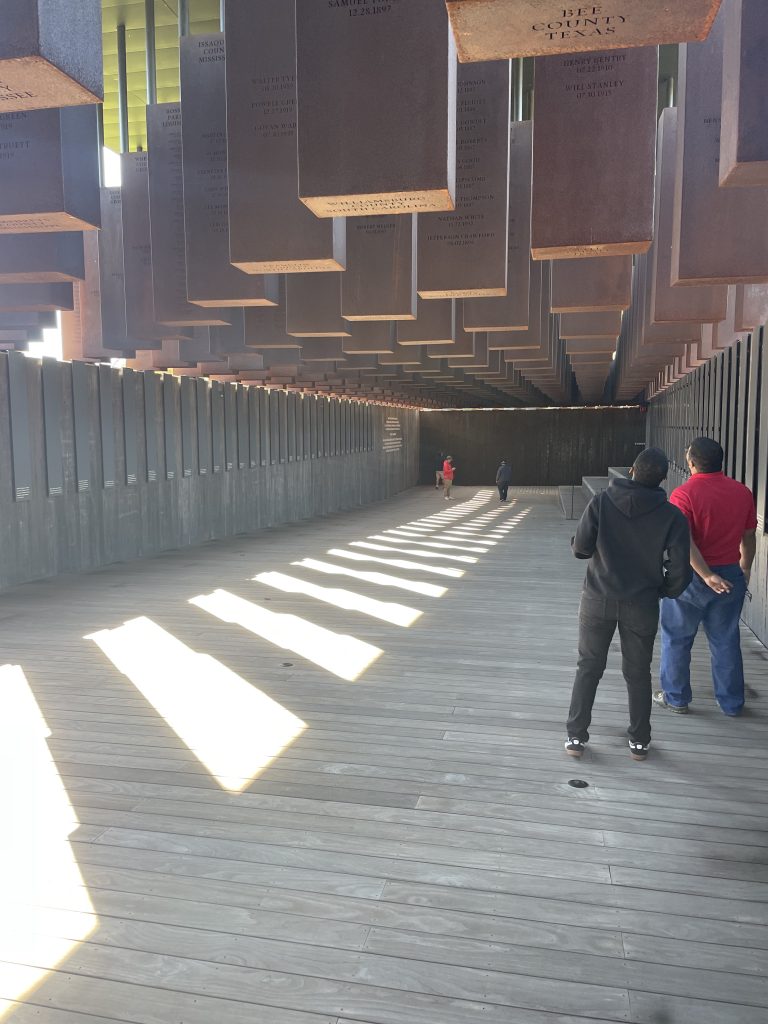Blog by: Clayton Allen ’23, Chase Breaux ’24 and Cory Taylor ’24

The Legacy Museum, in Montgomery, Alabama, tells the history of systemic racism in the United States, going from the Atlantic slave trade to mass incarceration.
In Associate Professor of Theater Heidi Winters Vogel’s Civil Arts and the Black Arts Movement course, we read James Baldwin’s “Blues for Mister Charlie,” based on the lynching of Emmett Till, a 14-year-old Black boy who was killed in Mississippi after allegedly whistling at a white woman in 1955. Having read several books based on the case prior to the immersion trip, this case was one that consistently bothered us on several levels. It serves, in our minds, as a depiction of how ruthless, irrational, and violent racism truly is in nature. One wall in the Legacy Museum listed names of lynching victims across the country and included several of their ages. We realized then that while Mamie Till’s decision to have an open casket at her son’s funeral brought much-needed attention to the violence of lynching, many other Black children also suffered. Emmett Till’s death was not an anomaly, even as a boy.
The exhibit that focused on mass incarceration resonated heavily as well. Having written papers on the ways in which mass incarceration is the continuation of slavery, we were knowledgeable going into the trip on how it came to be. However, one part of the exhibit served as a much-needed reminder that our generation is not far removed from efforts to reduce Black people to inferior creatures. It focused on an official from the Nixon Administration who admitted that the “War on Drugs” was intended to target Black Americans disproportionately. This reminded us of the Southern Strategy, which an official from the Reagan Administration discussed in an interview years later.
The exhibit also was a reminder of the Critical Race Theory debate going on today. The term is being used as a cover for various aspects of history regarding race. In certain states, systemic racism lessons, Dr. Martin Luther King, Jr.’s “I Have a Dream” speech and other teachings are being banned. These issues are being manufactured to systemically target, criminalize, and erase Black Americans and Black history. This emphasized the importance of continuing the struggle our ancestors fought.
When taking the short ride on the shuttle bus to The National Memorial for Peace and Justice, we had no idea the impact this site would have on us during this trip. We were aware of widespread lynching and terrorism that plagued the South and our nation during the early and mid-20th century. We did not know, however, just how violent and disgusting these acts were in their individual instances.
The descriptions of reasons for the lynchings was the first thing that impacted us during this experience. Many descriptions showed that these killings were executed for minimal, and completely harmless acts by African American individuals, who lost their lives in terrifying ways. The endless rows and columns of metal monuments on the floor and ceilings symbolically displayed how widespread and common these acts of terror were. Many of these metal boxes had names and dates on them in the county they represented, showing a culture of racism and violence in individual places. Each name had a story on these boxes, and each county had a story as well. Many were not named at all and just labeled as “unknown.” This was deeply striking, knowing that a life was taken so violently and evilly, and that a human being’s name will never be recognized in history. We all were overwhelmed in thinking and taking in this memorial, because every name was a life taken, and more commonly than not, no one was ever held responsible for these acts.

Located right across from the state’s capital building, the Museum of Alabama served as a fascinating look into how the state itself perceives its own history. The “Alabama Voices” exhibit gave a mildly condensed break down of Alabama’s more contemporary history, starting in the 19th century and continuing to present day. While making certain to include iconic Alabamians, including Hank Williams and Rosa Parks, we were not sure this exhibit necessarily caught the weight of some of this history. While it recognized that the Alabama Archives and Museum serve a completely separate intention than Equal Justice Initiative had, some offenses — such as not mentioning slavery during the Civil Rights portion of the exhibit — were a little too egregious to be forgiven.
In a conversation with the museum’s curator about the display of official Klansmen Robes, he said that he intentionally placed them around a certain corner to illicit shock from the museum’s patrons. To us, this was an honest attempt at holding the state of Alabama accountable and recognizing their culpability in the abuse and oppression of Black Americans, and Alabama’s leading role amongst their fellow southern states in oppression. Further evidence of the museum trying to deal with their states complicated history can be seen in their newest exhibit, which showcases the work of Alabama’s suffragettes. Ultimately, while we can’t be totally upset with how the Museum of Alabama decided to tell this history, we can easily say that it was perhaps the most timid when it came to fully addressing the Civil Rights Movement, and the terrible conditions that precipitated.